Garden fence color ideas: 14 on-trend tones for your plot's perimeter
Enhance your boundary with these garden fence color ideas and visually transform your outdoor space
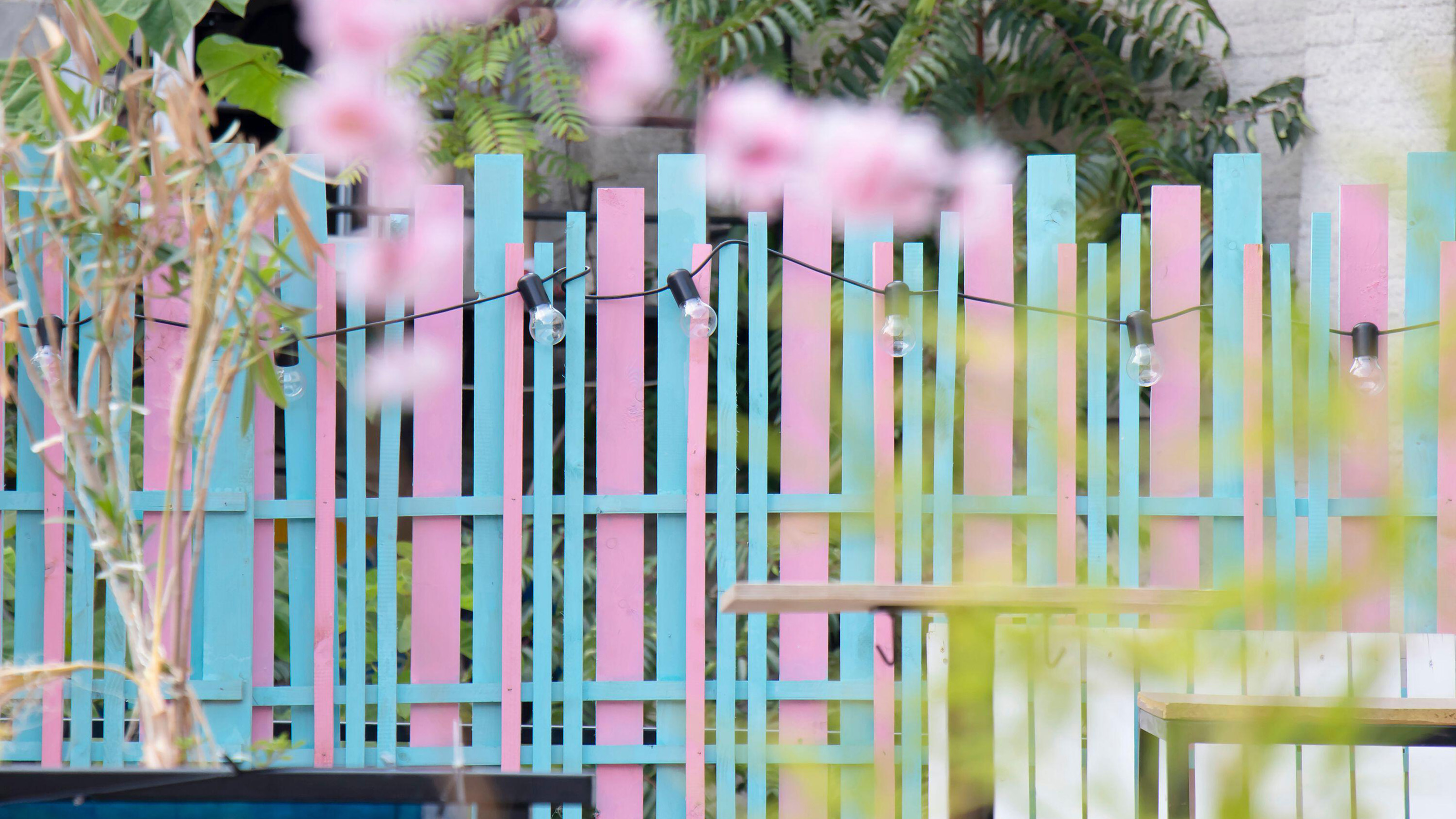

Updating your garden fence color ideas is a brilliant way to spruce up your backyard. Perhaps you've moved into a new house and want to make your own mark on the space, or you're just a bit fed up with the color you have and fancy a change.
Whatever your motivation, sunny dry days are the ideal time to get outside for these types of garden jobs. It's important to note, however, that not all fences can have their color altered. Wood is easily painted whereas vinyl and composite fences aren't.
'When considering your project, wood and metal paint can be just as effective as a masonry paint to create an individual and premium style,' says Matthew Brown, Sadolin & Sandtex Technical Consultant. 'To the front of your property a fresh coat of paint for railings, gates, fencing or a front door can immediately impart your style or improve curb appeal. In your personal space at the rear of the home, why not look to be a little more adventurous with your garden fence ideas.'
Give boundaries a lift with these garden fence color ideas
From pretty pastels that will instantly lift a backyard to darker shades that will act as the perfect backdrop to your planting, there are plenty of garden fence colors to choose from to suit your outdoor space.
1. Bold black
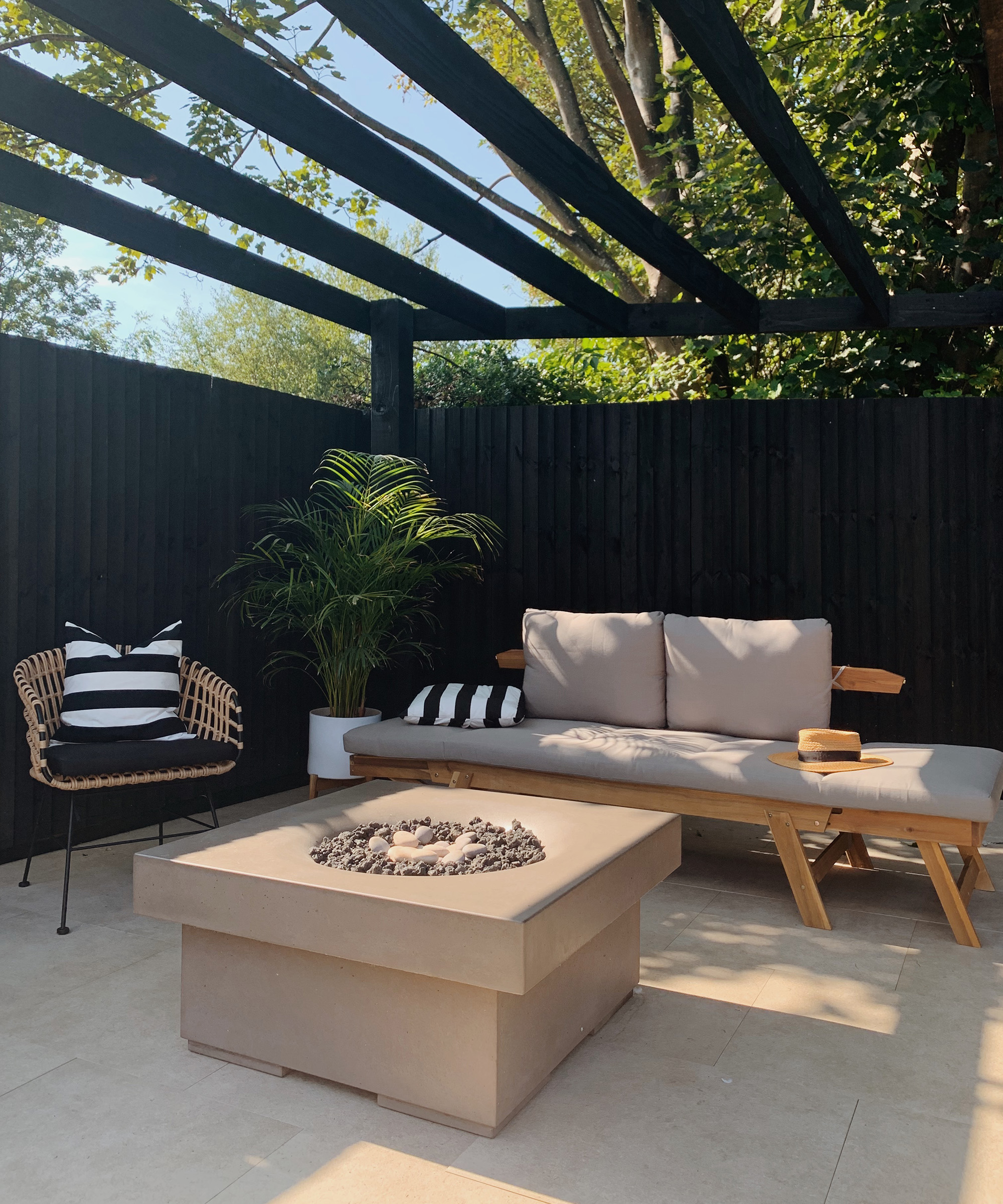
'While a black fence may appear aggressive, it actually serves as a neutral shade,' says garden style expert Samantha Jones from MyJobQuote. 'Because it has a bit more edge than lighter tones, black is suitable for a more modern feel in your yard. What makes black such a great choice is that it allows your favorite plants for fence lines to stand out.
'The dark surface completes the layout by forming a different frame around the perimeter. If you want to define your own space, consider dark fencing, as a black edge will provide much more definition than a lighter shade.'
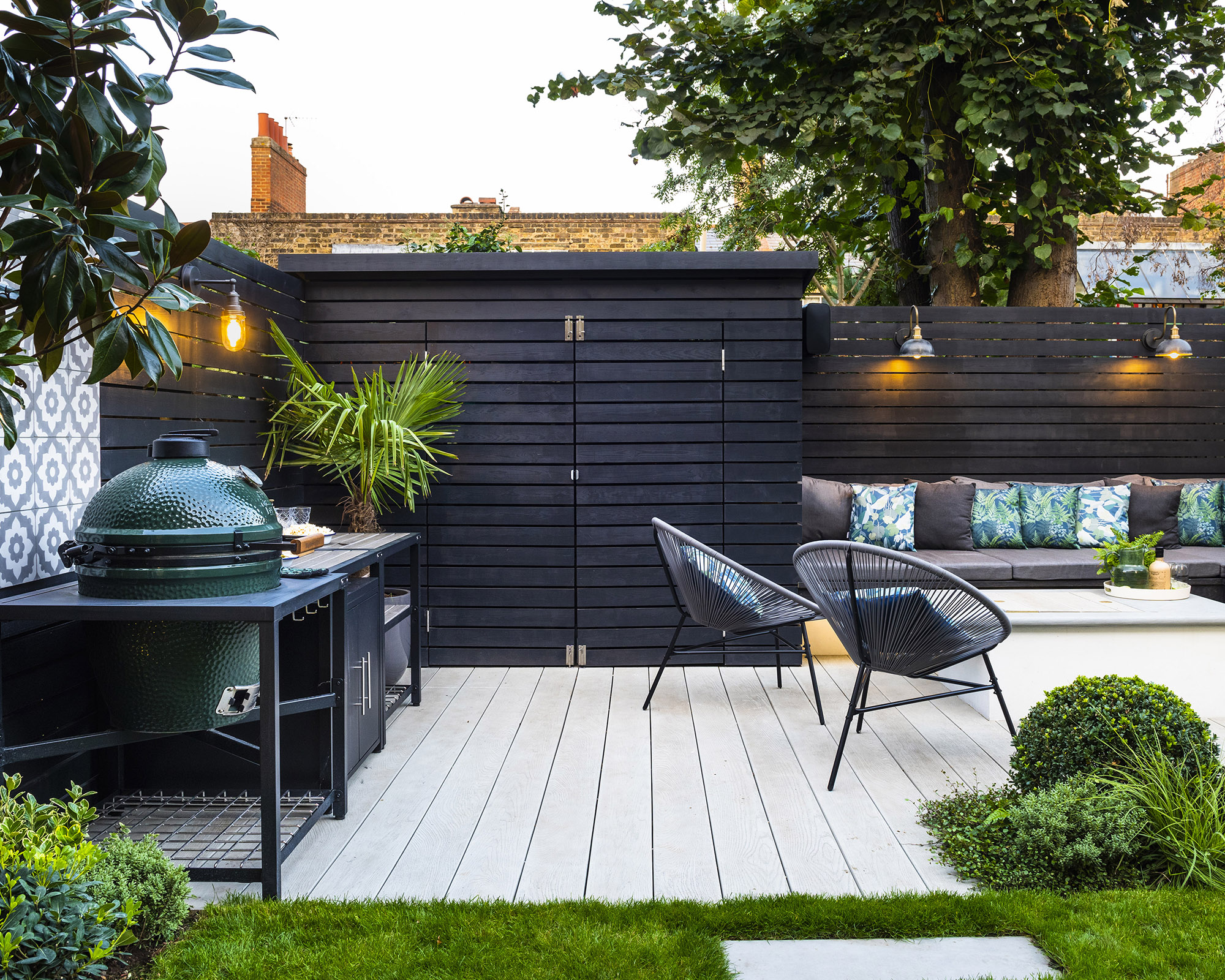
Enhance colors with high contrast
'A dark fence works perfectly in both traditional and contemporary garden spaces,' says Marketa Rypacek, Managing Director, Industville Ltd. 'It provides the perfect backdrop for plants and flowers to really stand out, as well as offering a wonderful contrast to make a statement with stylish metallic accessories and pale landscaping.'
When painting natural wood fencing, ensure surfaces are clean, dry and sound, advises paint expert Matthew Brown from Sadolin and Sandtex. 'Don’t decorate over something that isn’t in a good condition,' he says. 'New coatings only adhere to previous coatings that are in a good condition or a clean timber surface, so anything flaky needs to be sanded off.'
On timber fences, only use the best exterior wood paint for your chosen fence color too so you can be sure it will create a professional looking finish.
2. Natural wood stain
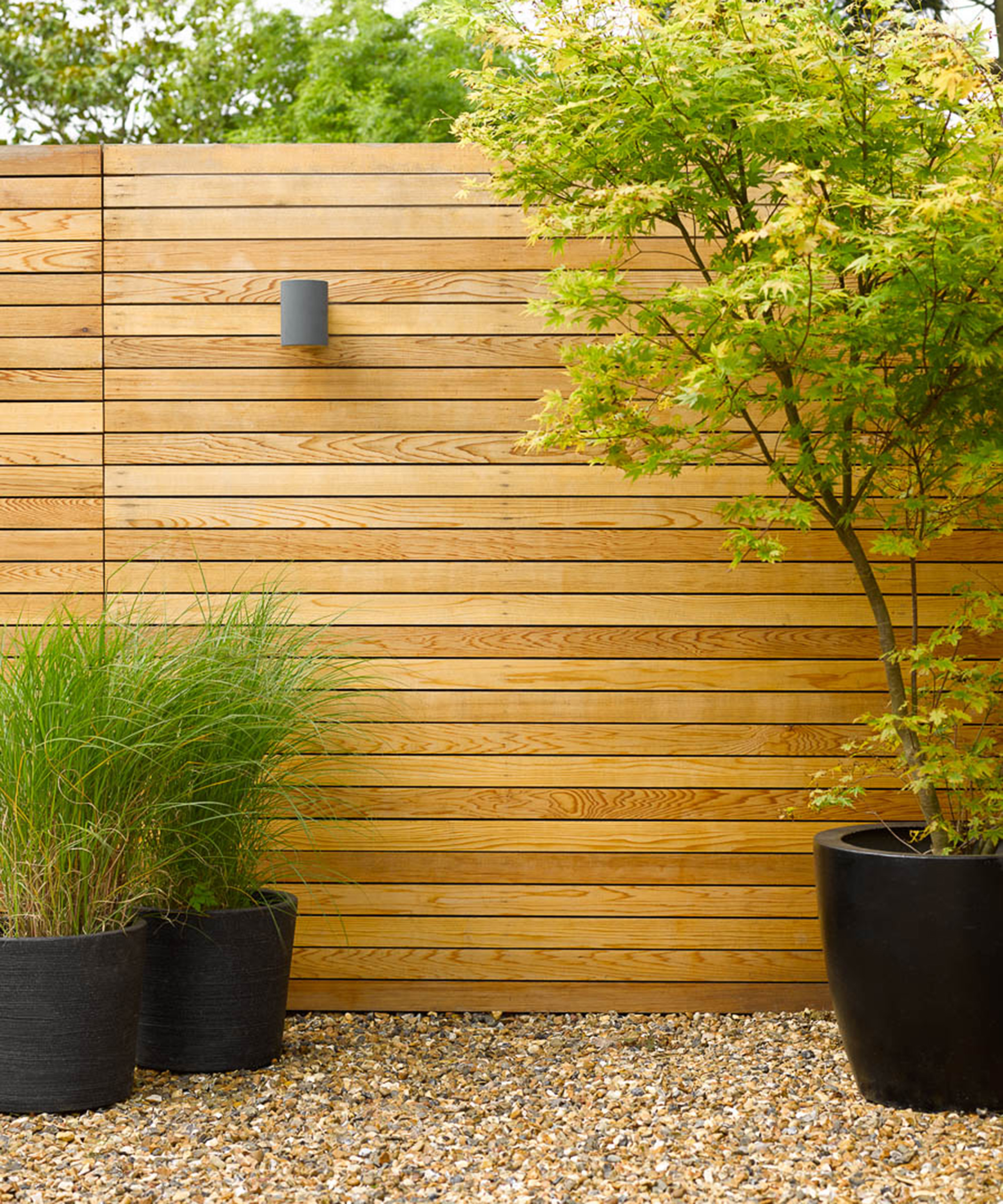
If opting for a natural wood appearance, you can finish with a protective coating of Sadolin wood protector
A natural wood color fence can make very appealing garden screening in its own right so you may not want to cover it up with paint. Use a protective varnish or stain to enhance the look and protect the wood.
Paint trends may come and go but keeping the classic wood shade will mean that you'll create a timeless look which will have wide appeal. Far from looking rustic, a smooth wood grain can give a contemporary feel which at the same time lends itself to a more naturalistic look for your garden. It's also easy to add a coat of paint if you fancy a change further the line.
3. Charcoal gray
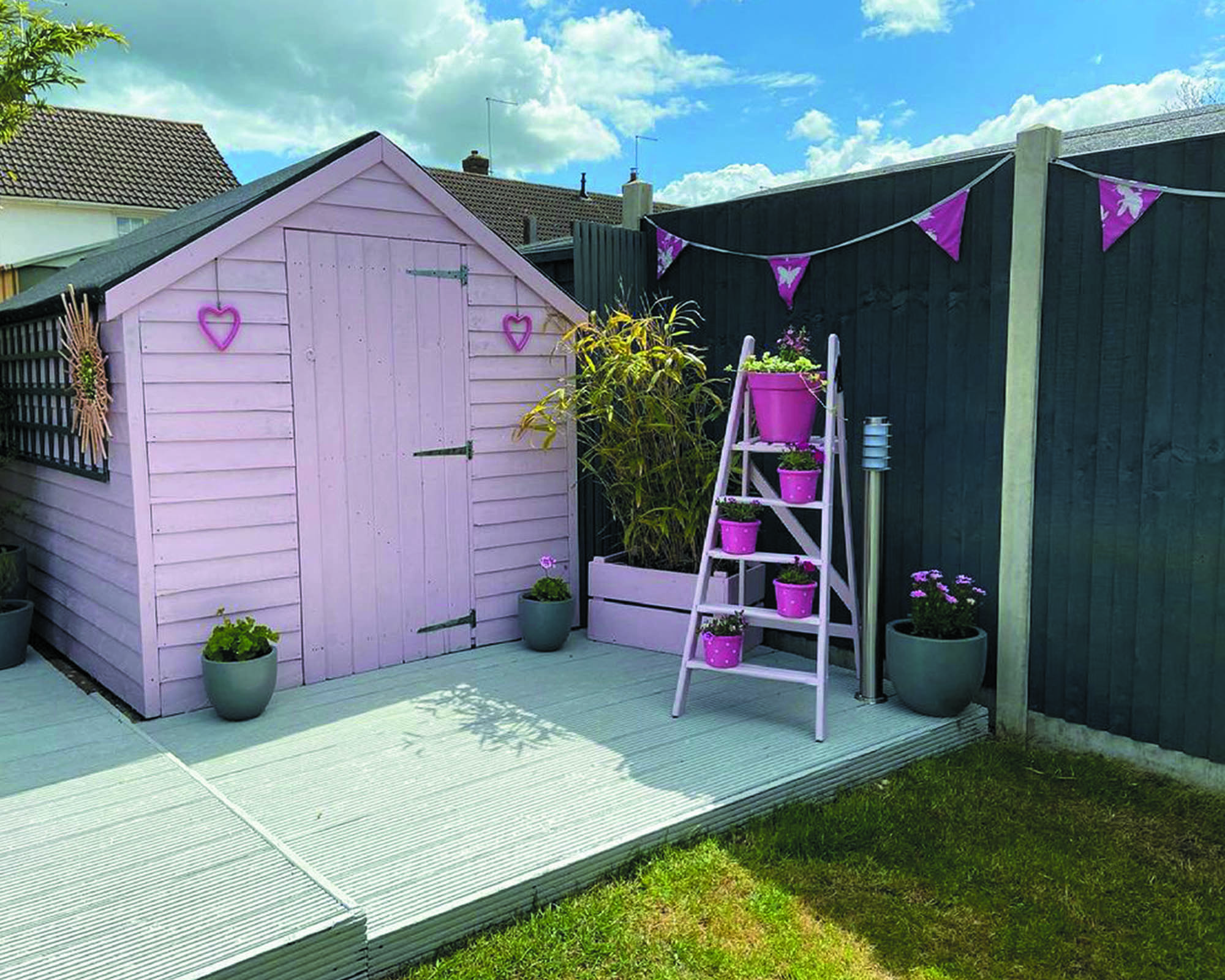
Dark gray painted fences can allow other garden features to stand out in your scheme
Whether you're looking for the latest privacy fence ideas or a simple way to section off your plot, using darker gray tones can help make smaller spaces feel bigger as they add a sense of depth. 'They can also be used in bigger outdoor areas to emphasize what space is available, whilst establishing shape and boundaries in your garden,' says Charlotte Radford, Senior Product Manager Emulsion at Valspar.
'Stony gray colors can help achieve a deep and mature backdrop for your garden foliage and accessories,' she adds. 'Using a gray with a slight blue undertone will help promote other brighter colors that either naturally or artificially make up your garden landscape, as well as promoting a calming atmosphere that is carried through the seasons.'
If you're updating other areas of your garden at the same time, there's no rule that says that your shed or decking ideas need to be the same gray color as your fence, so you can introduce a more playful touch on these garden structures.
'Colors that complement gray are pinks and coral oranges for a summery and vibrant feel,' says Charlotte. 'Adding a pop of color draws the eye in and helps create a focal point in the landscape. For a more relaxing theme, pastel greens work well with dark gray and will complement the shades of your garden’s foliage and plants.'
4. Pretty pastels
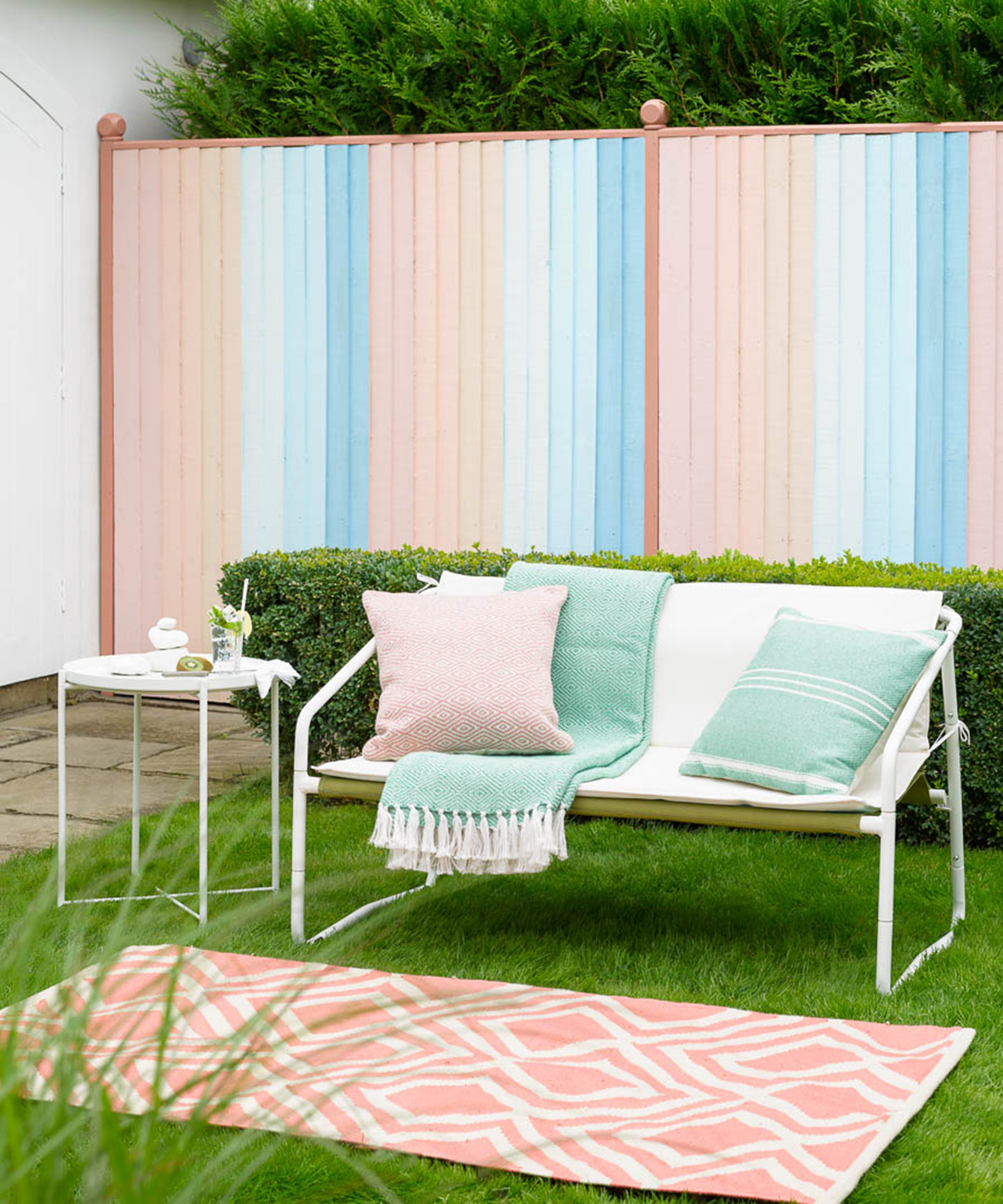
Giving your existing boundary a unique lift can be as simple as updating it with a few complementary shades of outdoor paint, as shown in this striking scheme.
Matthew Brown, Sadolin & Sandtex Technical Consultant, recommends that you choose tonal shades rather than clashing colors. A number of clashing brights could end up looking quite jarring and will eclipse all other features in your garden. Remember, you want your garden fence color ideas to enhance your space, not detract from it.
'Once you have picked the colors you want to paint your fencing, pick out the starting color and paint two trellises starting from the left,' says Matthew. 'Then choose another shade and paint the next four trellises in this. Continue with your additional color choices and repeat the steps to achieve a cohesive look.'
Whatever fence type you have in your plot, just make sure you use products that are suitable for exterior features – in other words, leftover paint from your living room walls is a no go.
5. Grey and green
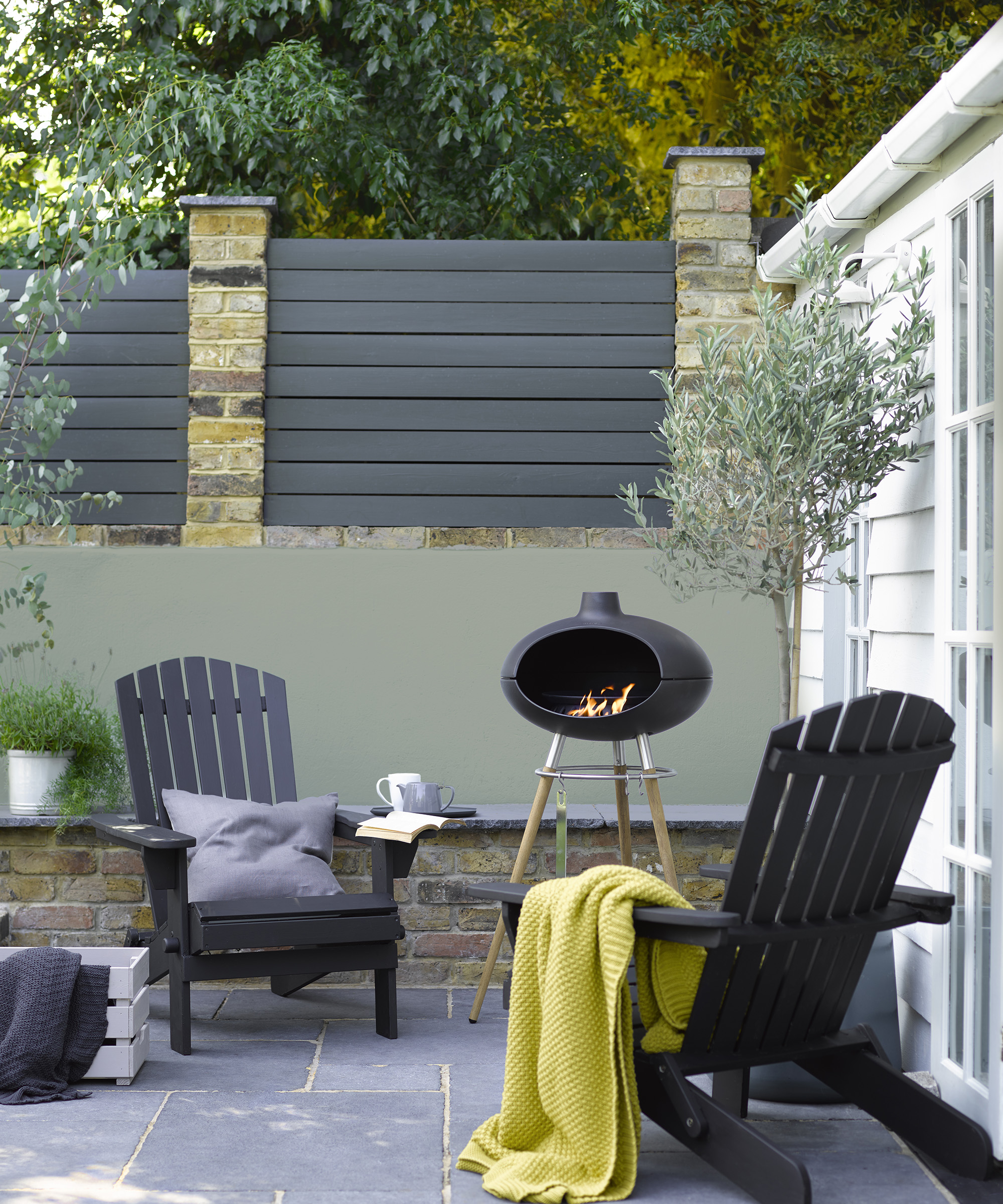
A combination of paint colors can boost a small tiled patio
High garden fences can run the risk of making a small garden feel oppressive, but introducing some color can help to open up the space and create an interesting focal point.
Combining different textures and colors is a great way to boost the interest further. In this patio space, a green painted band softens the look of the garden wall, while the complementary dark-gray slatted fence panels highlight the darker tones in the brickwork.
'Green comes in a variety of tones, and if a deep forest green isn't your style, try a lighter shade that matches the surrounding plants, trees and foliage,' says Samantha Jones.
6. Pale neutrals
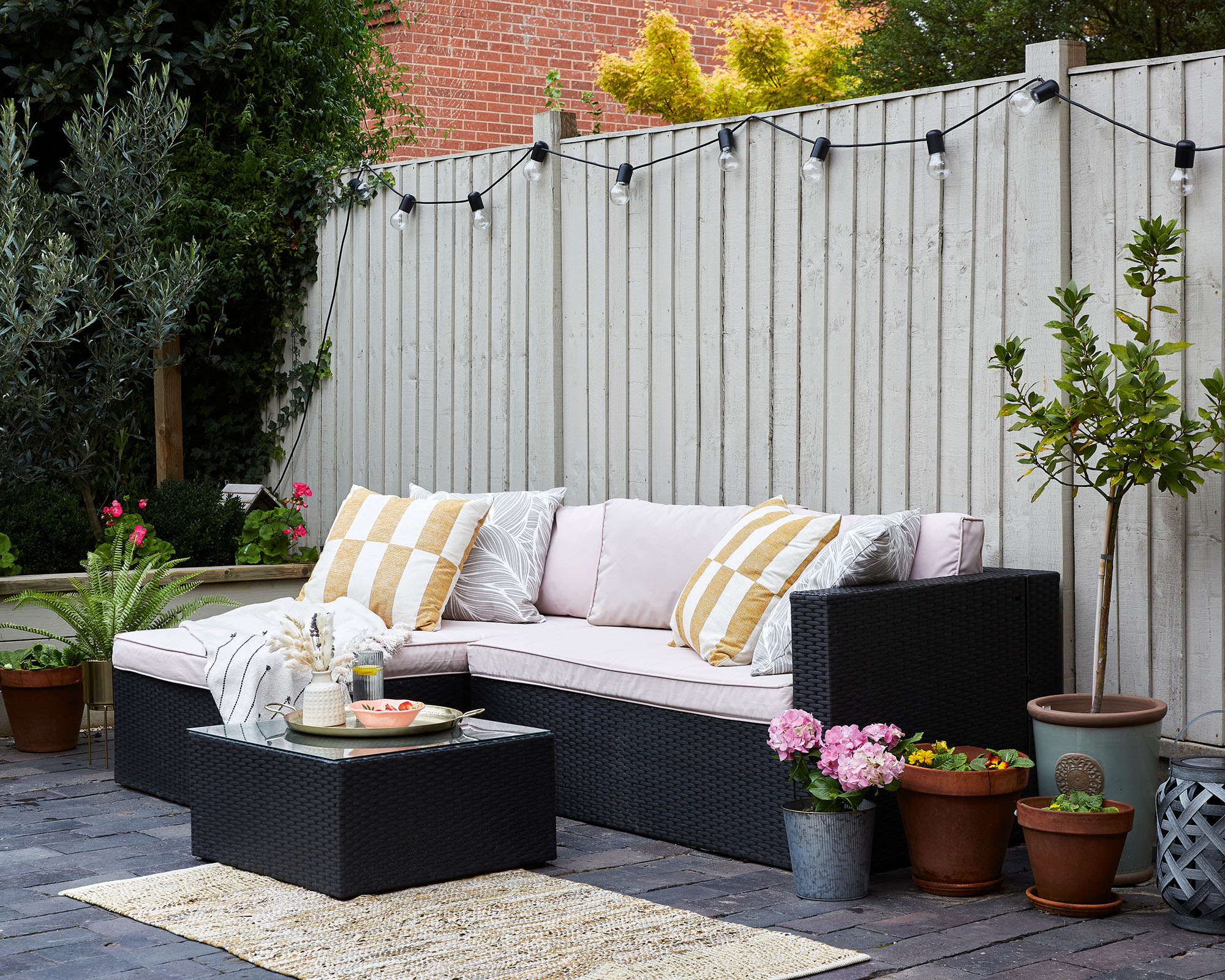
Light colors will enhance the sense of space
Lighter garden fence color ideas will generally reflect natural light rather than absorb it, making them a good choice if you want to brighten a dark patio or courtyard space that doesn't benefit from much sunlight.
If you opt for a really pale color or white, try to choose one with a blue undertone rather than yellow, as white with a hint of blue will add more depth to the paint.
'Pale tones add a luxurious and contemporary feel to your garden color scheme when combined with neutral coloured surroundings and outdoor furniture,' says Samantha Jones. 'This can work particularly well in a plant-filled garden because the greenery will complement a pale fence.'
7. Two-tone gray
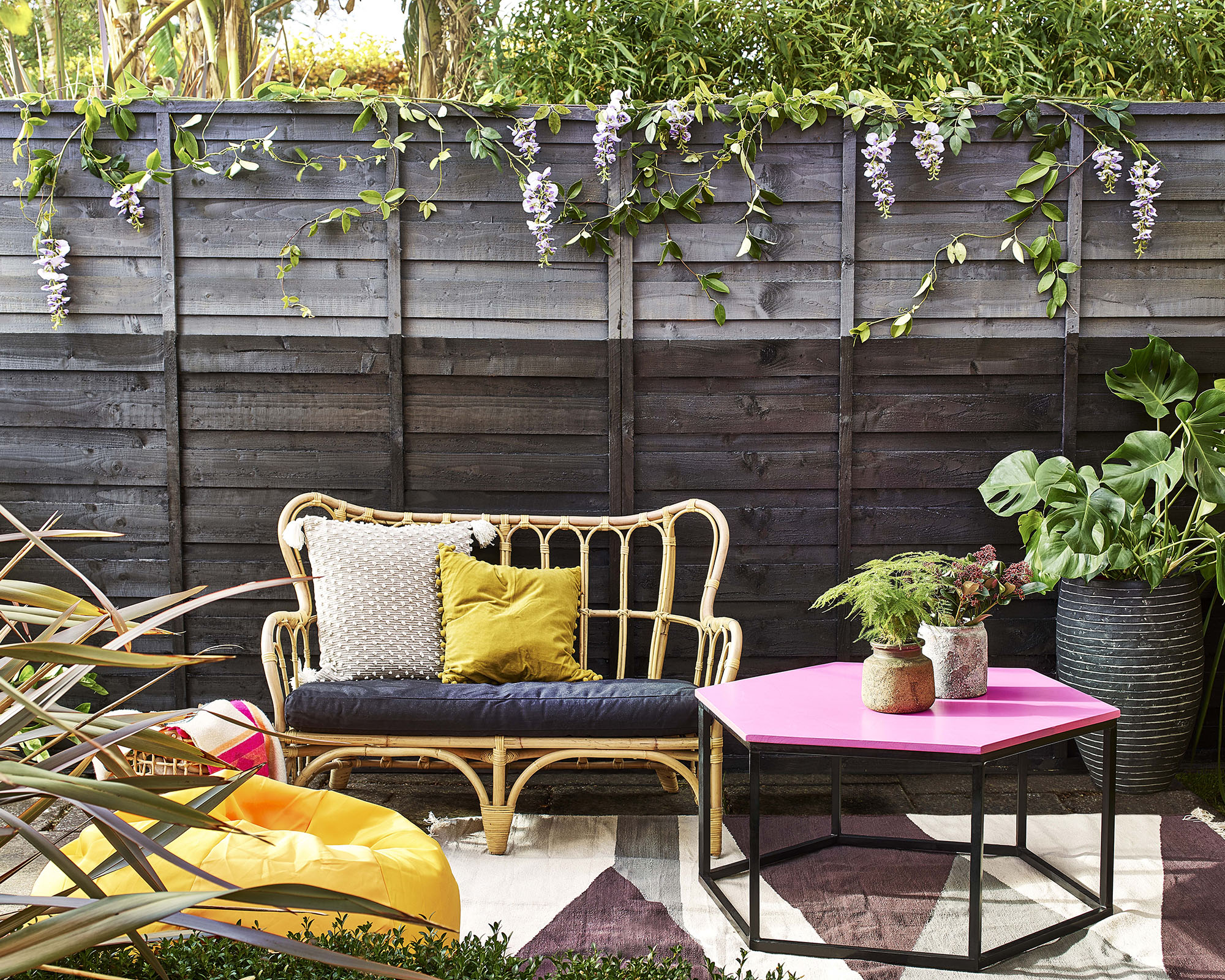
Introduce pops of color with accessories
You can transform your outdoor space into a stylish, modern garden haven by painting a cool gray color on your fence. 'Gray paint is not only on trend, but it also provides long-lasting protection to exterior wood from the elements, which means it will keep your fence looking good for longer,' says Samantha Jones.
Gray is a versatile paint color that works well with everything from modern fences to traditional picket fences. It's a middle ground between black and white, so if you're a bit unsure about going for something too bold or stark then gray is a safe bet.
For a modern garden fence decoration idea, opt for two different shades of gray and paint the lower two thirds of the fence in a darker tone and the top third in a lighter version of the same color.
8. Natural shades
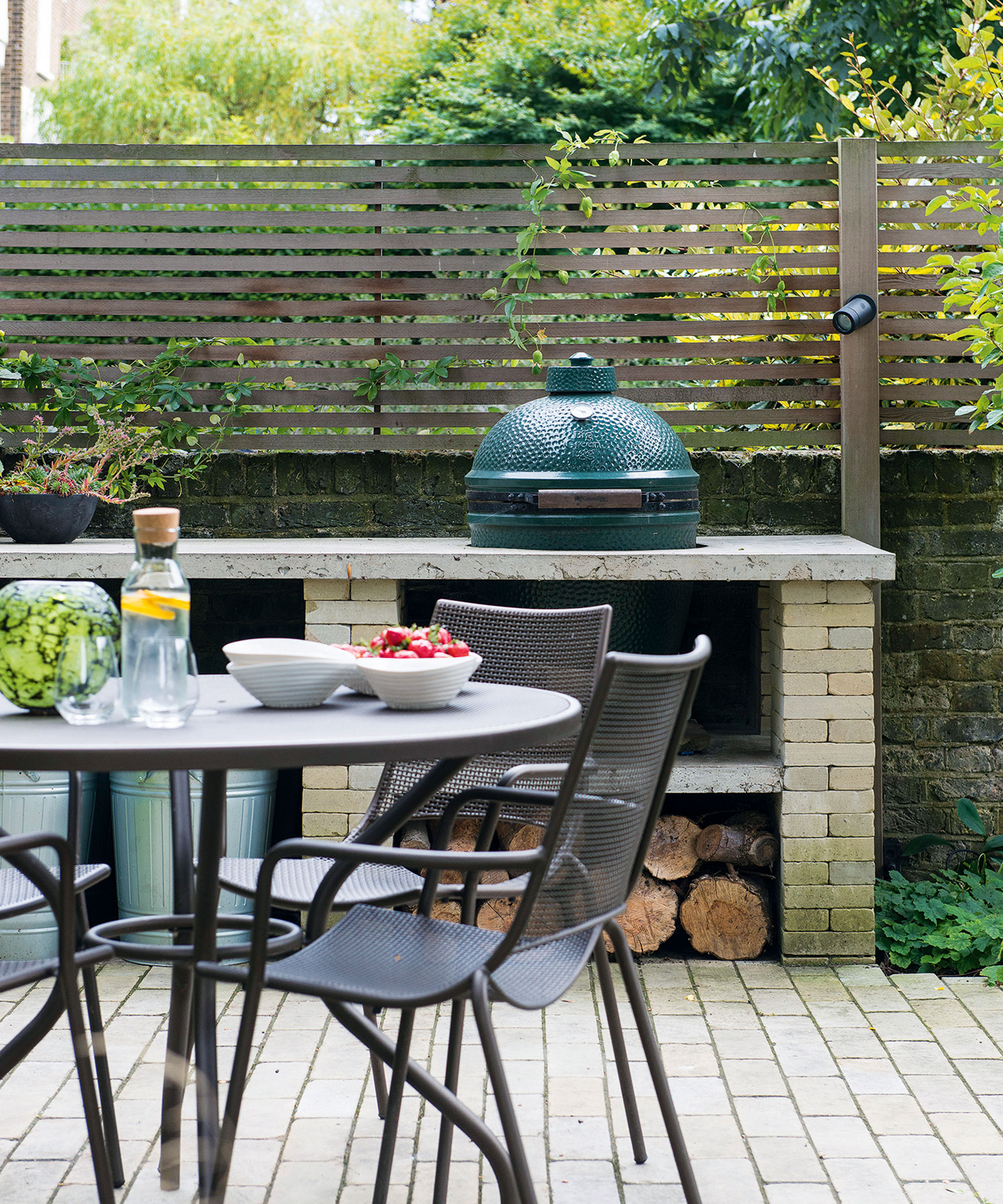
If a pared-down look is more your style keep fence colors simple
Not everything in your backyard has to make a statement. For instance, you don't always choose a dramatic paint shade for the walls in your house. Sometimes a neutral backdrop is all that's needed to create a serene space where one element doesn't overpower the other.
So rather than making a stand-out statement, you might just want a garden boundary to blend in with its surroundings and blur the lines between the edge of your garden and the surrounding landscape.
If there is lush greenery in a neighboring garden for example, you might wish to borrow this as a feature for your own garden. So a natural wood shade with peep-through slats would be a great choice, as in this project.
9. Earthy colors
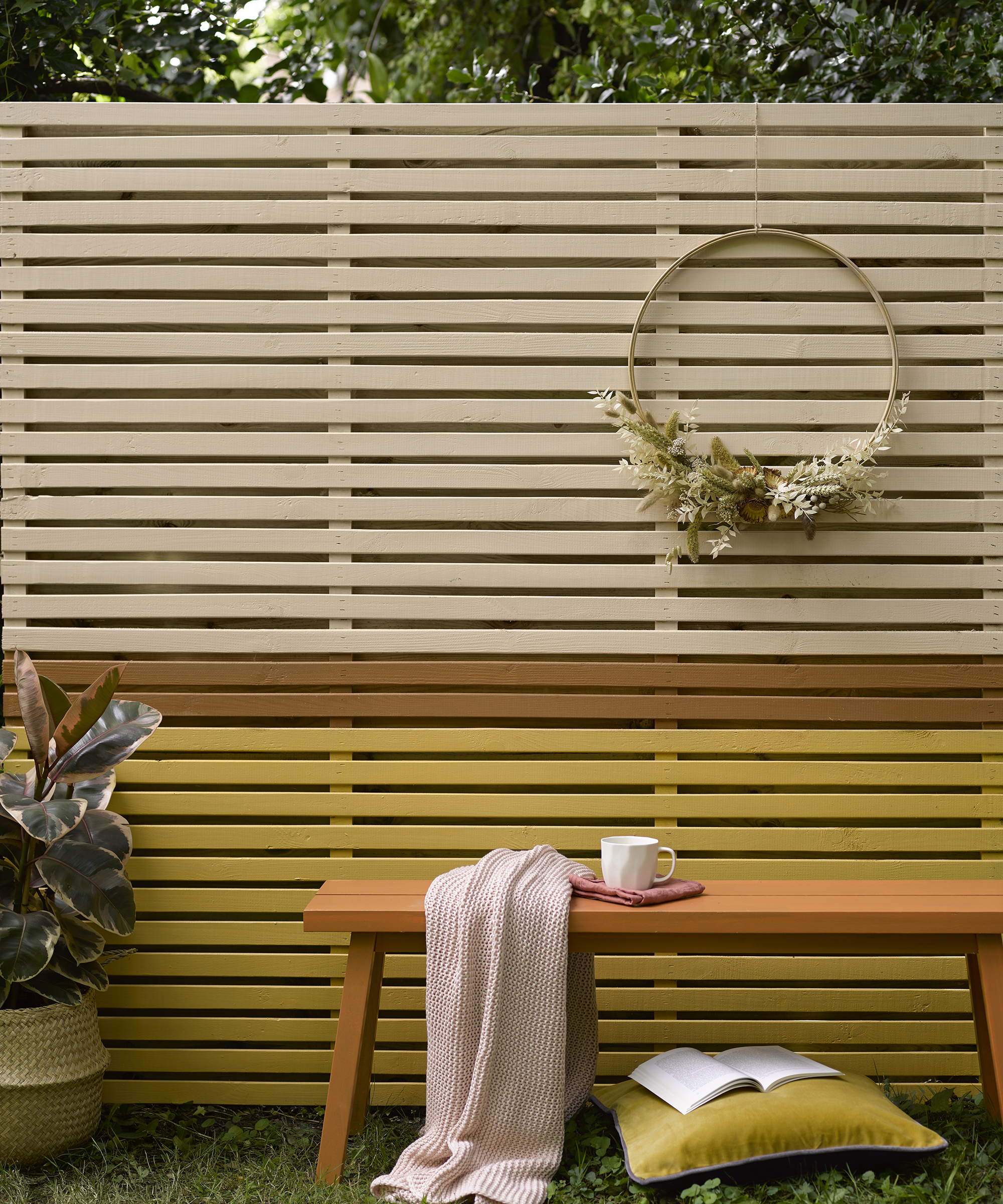
Break up your garden fence color with a horizontal stripe
If you're looking for something a little different for your landscaping, why not mix it up and pick a trio of shades for your garden fence color ideas?
Choosing three tonally similar shades will ensure that the finished paint effect is harmonious rather than clashing, while splitting the fence lengthways with bands of color can create interest and help to open up the space.
10. Paintbox brights
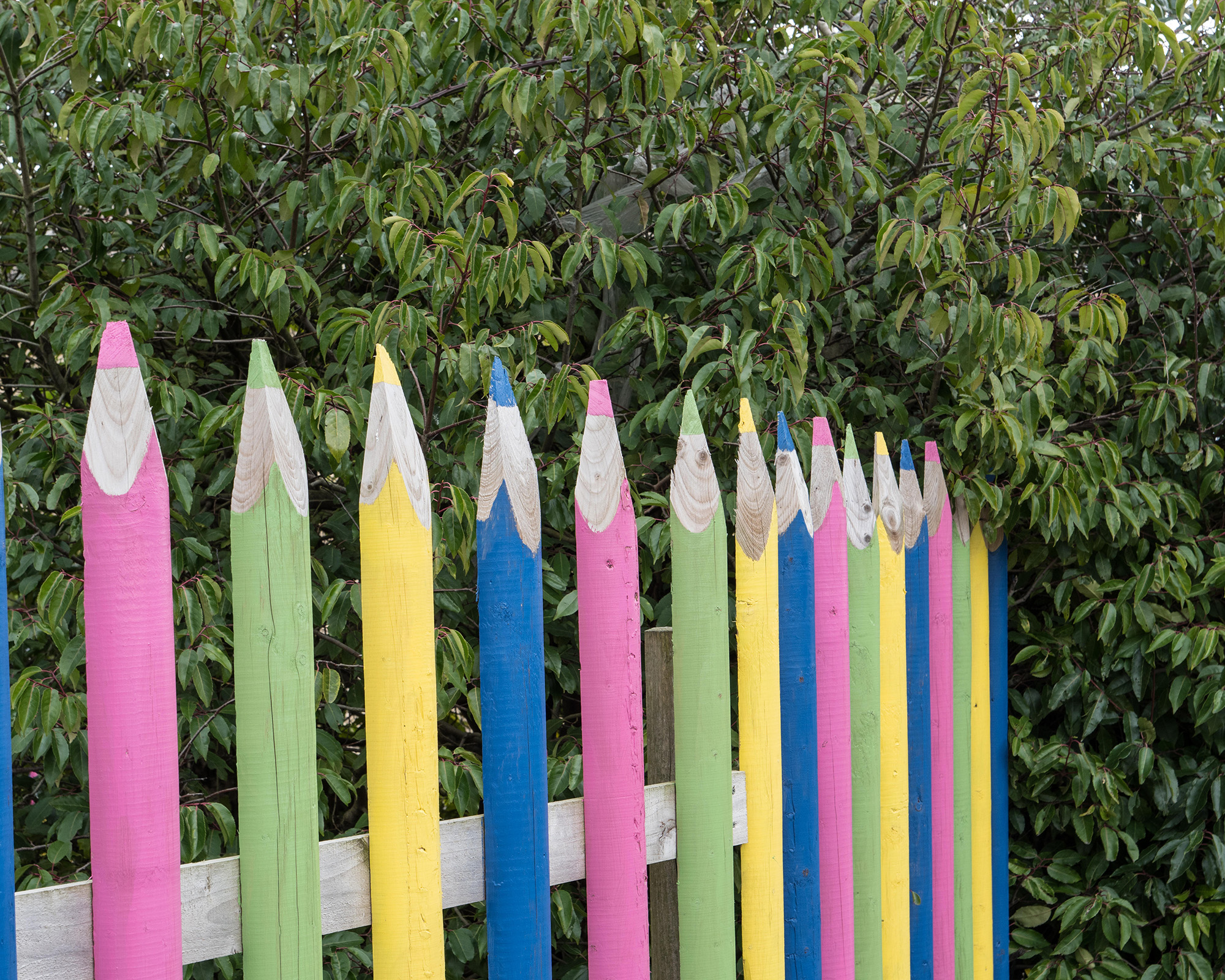
Release your inner child with this striking color combination for your fence
Whether you have kids or are just looking to indulge your inner child, this scheme won't fail to delight. It would work particularly well with an existing picket fence.
So if you're looking to give a playful edge to your entire space, or use it as a garden divider in a family space, then pick up a few sample pots in an array of shades. The more the better for a proper paint-box of delights.
To create this look, paint the full length of your fence panel. Leave the pointed top bare if it's a natural wood color, or paint it to look like the top section of a coloring pencil and leave to dry. Finish by adding a splash of the main color as the point of the pencil.
11. Classic white
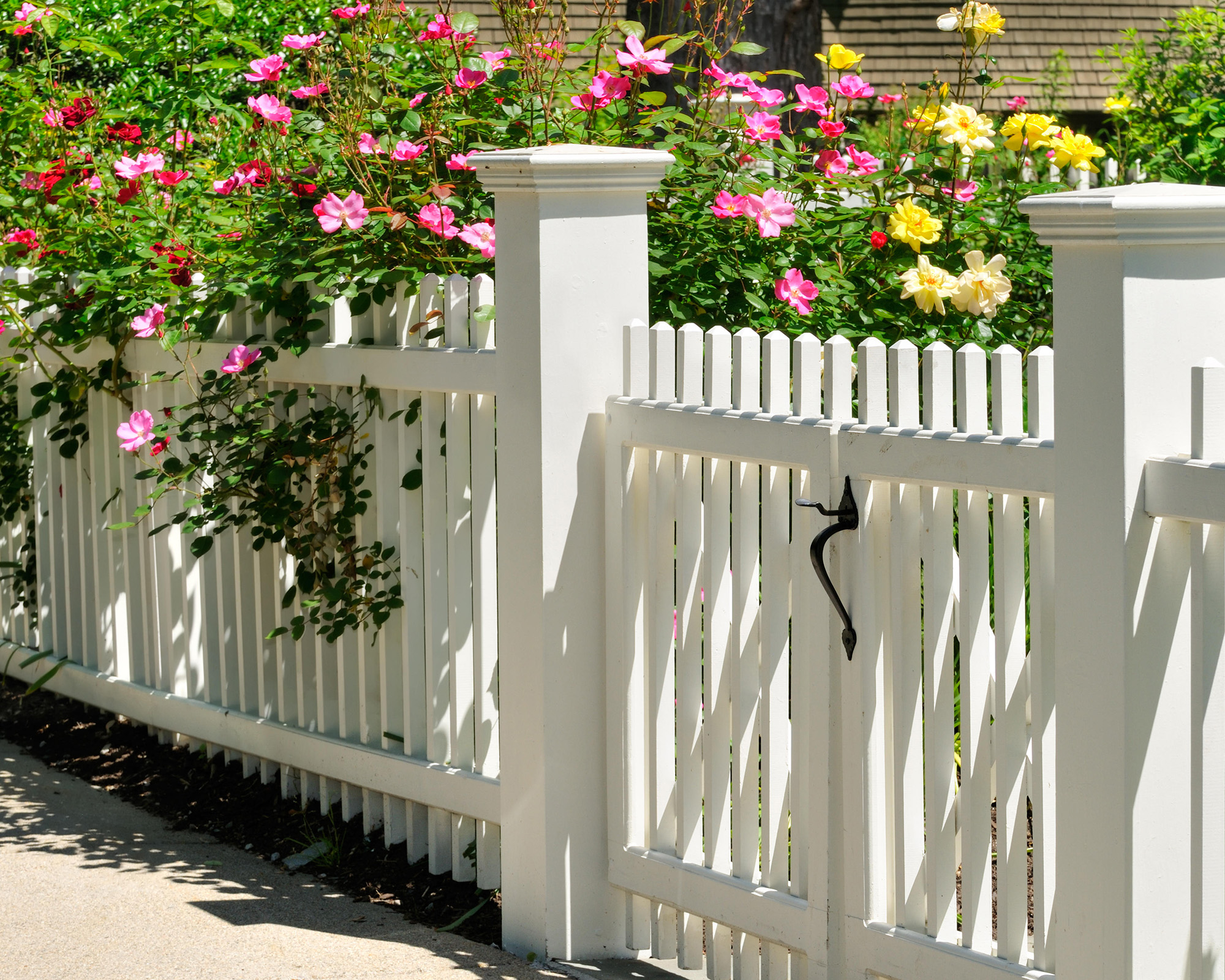
A white picket fence is the bucolic fantasy
White is a classic color choice for fences if you're looking to create quintessential cottage garden ideas. After all, nothing says elegant country style more than a white painted picket fence.
It's best to avoid bright colors if you want to create a traditional look as these can be overwhelming on areas like fence panels. You can always pick out bright colors in your furniture and pots if you're craving that extra pop. And, perhaps most importantly, it will allow your billowing cottage garden plants to really sing.
12. Pink and blue stripes
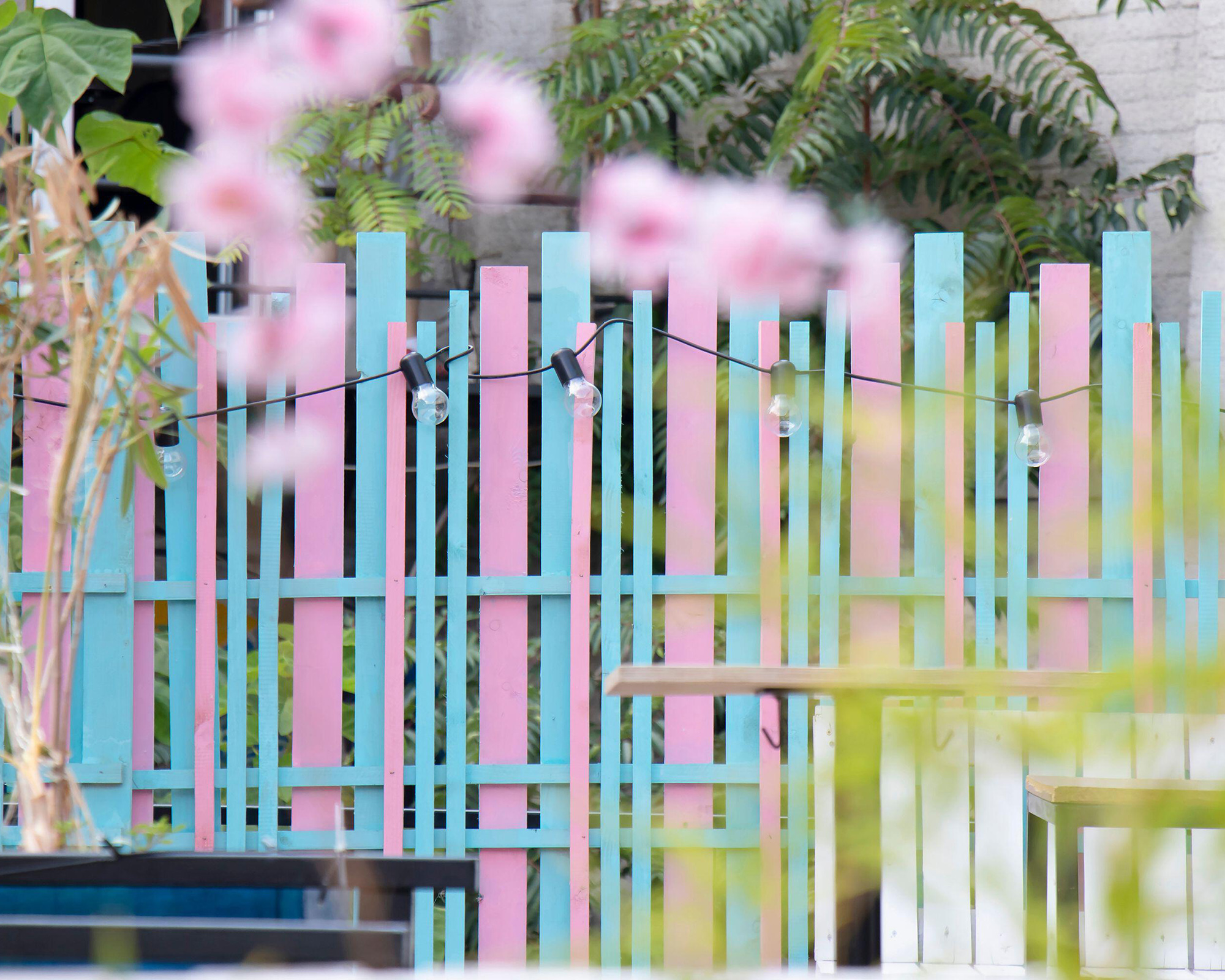
Fun tropical colors will give a summery feel to your space
Make it pink or make it blue? Why not both! Fences which have stripes of color tend to be in blocks. However if you're wanting to create a dreamier look with plenty of depth, then try a mix of vertical and horizontal stripes which overlap each other at irregular intervals.
The fresh pink and blue creates a real party vibe so this could work well as a pool fence idea. That way you'll have the joys of summer all year round (well, not quite, but almost!). Finish off with some festoon light ideas, because why wouldn't you?
13. Blue and white nautical design
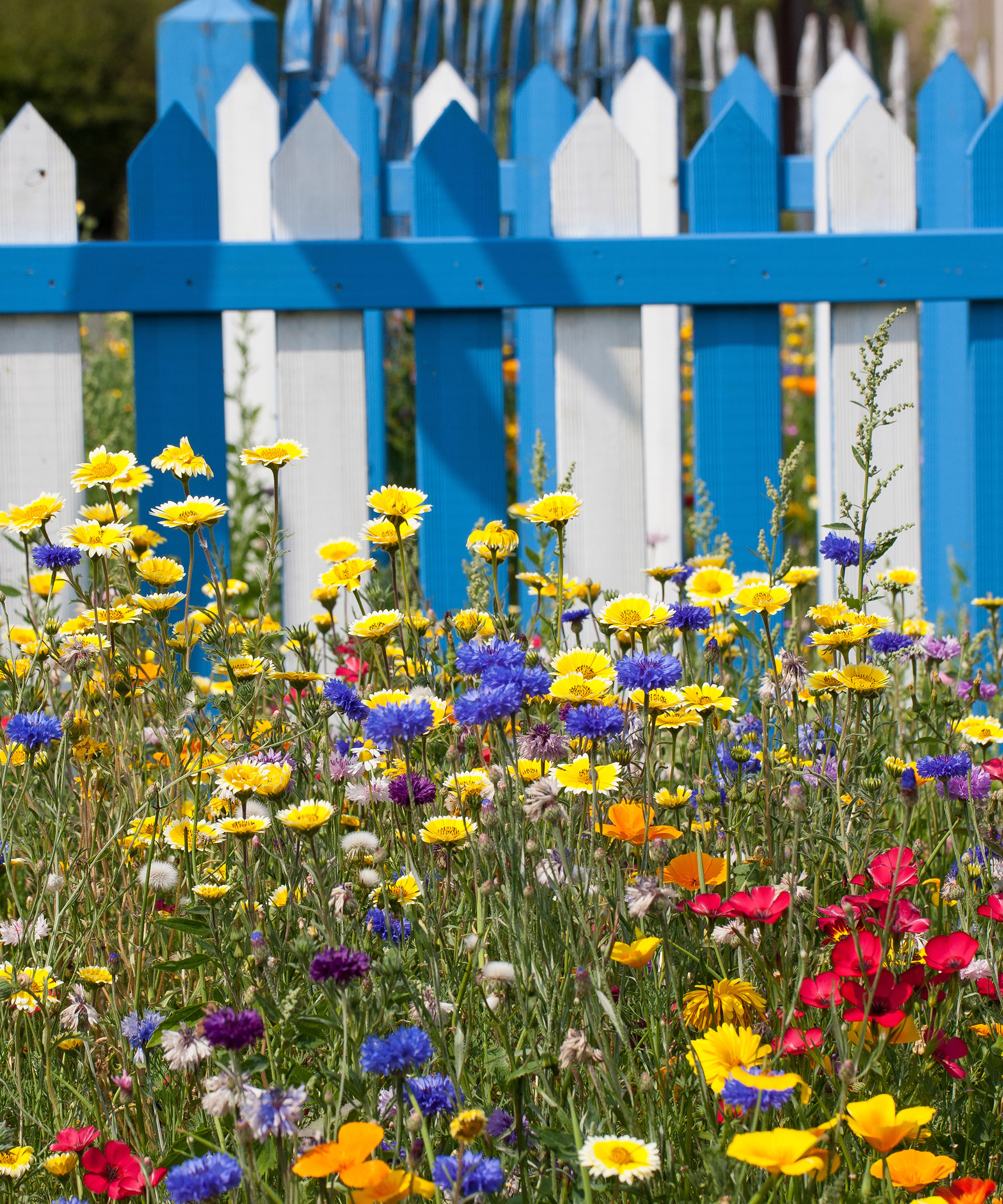
A blue and white striped fence is ideal for a coastal style garden
Nothing quite says coastal style like a classic sailor blue and white nautical stripe. If you have a coastal garden then play up to this nautical theme by reflecting it in your garden fence color ideas.
Add thoughtful details like interesting pieces of driftwood and shells from your beach combing to your beds and borders to pick up on this theme throughout your space. And of course, add some of the best coastal plants to your planting scheme, with pops of blue to complement your new fence color.
14. Pretty pink
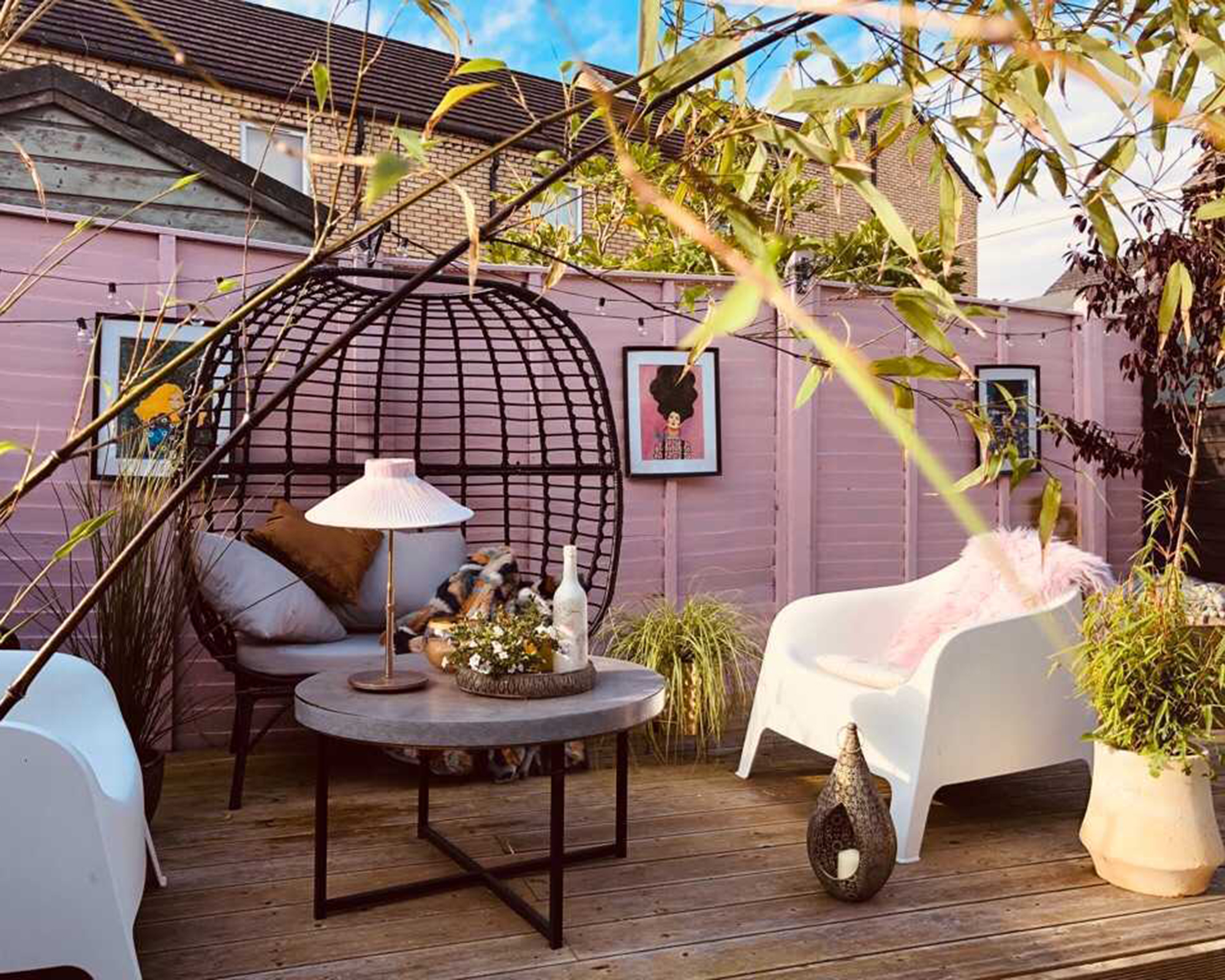
Donna @decorbydonna_ went for a pretty pink pastel color for her fence
It may come as a surprise to some of us to learn that soft pink is a color which has been identified as creating the illusion of more space, as Donna from @decorbydonna_ shows in her pretty decked patio area.
Sylvia James and Calum Maddock, an interior designer and a gardening expert from Homehow.co.uk say, 'If you are willing to be a bit more daring with your fence color, then a soft pink is the perfect choice, especially in the sunshine and when the sun sets. Lighter colors can often blur the boundaries of your garden and can make a space look bigger.'
Sticking to a single color is also the best option if you're searching for cheap fence ideas. It's easier to work out how much paint you'll require if you're just using one color, plus there's less chance of wastage when compared to painting a fence in several different tones.
What is the best color for a garden fence?
'Painting your fence a new color can make a huge impact on the look of your garden, so it's well worth considering all the different options, looking at different trends and researching what you like or dislike,' suggests Leigh Barnes of Jacksons Fencing. 'Whether you're planning a whole new design or just making some subtle changes by painting a fence, it may be worth thinking about choosing a color or tone for your fence in line with the surrounding area to see what best fits.
'There is no one perfect colour for a garden fence,' says Marianne Shillingford, Creative Director at Dulux, 'it all depends on the mood you want to create, the size of space and the kind of plants you have.'
'Earthy colors such as yellows, browns or greens, for example, are in keeping with many surrounding areas in the UK,' adds Leigh. 'Painting your fence can be modern and can act as an on-trend contrast to the more traditional aspects of your garden. A golden fence stain or dark timber color, meanwhile, is a good option if you're looking for something subtle but equally as attractive.
For practicality and long lasting good looks, Marianne recommends choosing a shade of green. 'It will blend in with the foliage and make the space look bigger – plus darker greens are great for adding a bit of sophistication whilst hiding a bit of dirt too. Paler blues and greens fill the space with a breezy freshness, which is perfect for young families who like to spend lots of time outdoors.
'Darker shades make all plants look amazing (even weeds...) and earthy stones and creams add a classic cottage garden feel that never goes out of fashion,' she adds.
Leigh Barnes agrees that blue and green colors are ideal for a modern scheme: 'Blue-gray or even contemporary green shades are ideal for making a refreshing statement with your garden fencing. These colors look particularly good set off against darker-colored plants and foliage to act as a standout feature.
'Overall cost wise, there are no major differences with either paint or stain,' Leigh continues. 'Each can have expensive or cheaper versions. Both will not heavily impact your fence, but paint may restrict the natural movements of timber. It comes down to whether you want to change the whole look and color of your fence with paint, or enhance the natural beauty of timber, with stain.'
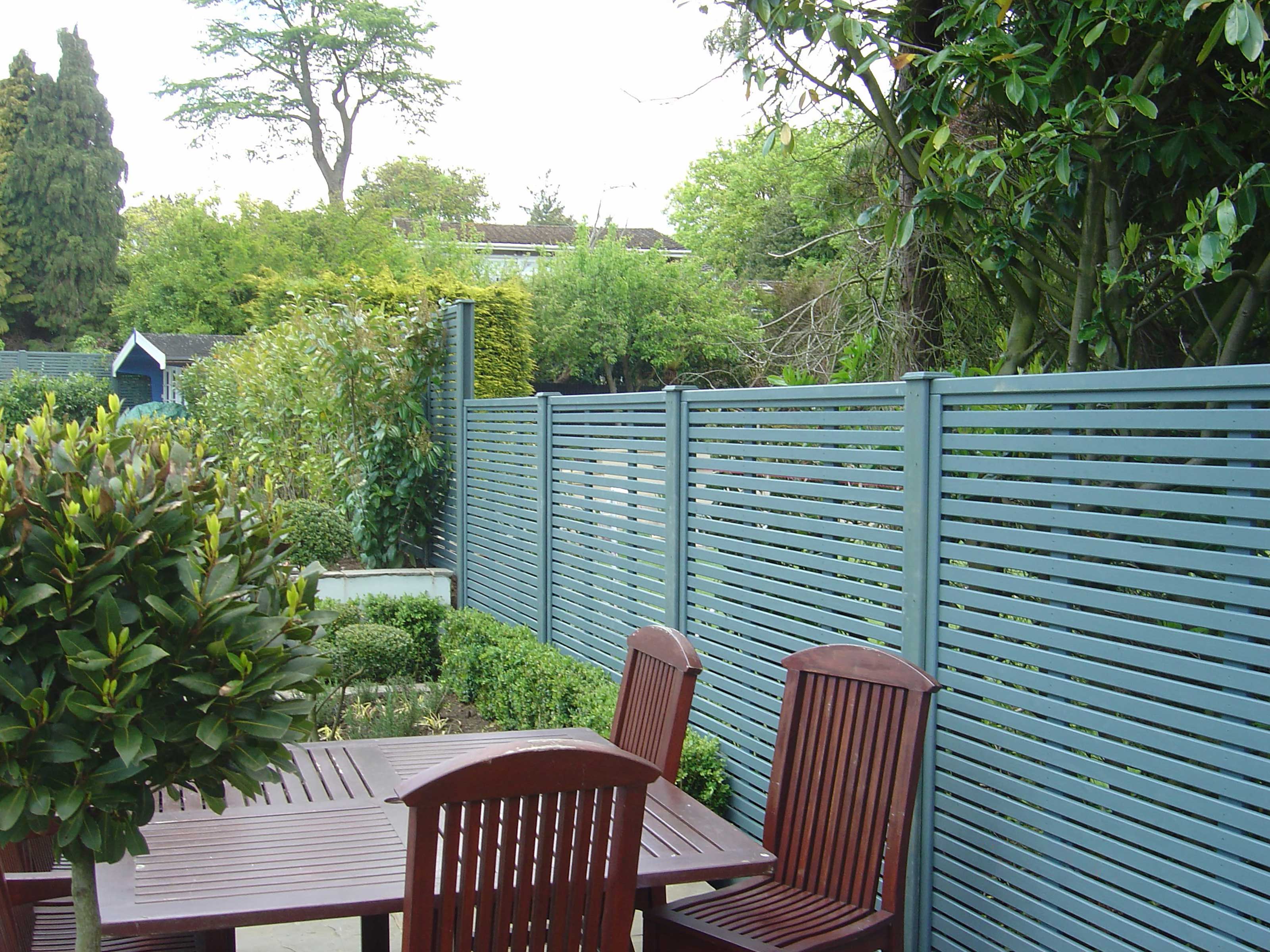
We love blue-gray garden fence ideas, such as this one from Jacksons Fencing
What fence colors are good for a small garden?
If you're wondering what color fence paint makes a garden look bigger, you have a few good options.
'White, cream and pale shades inspired by nature that reflect the light will always make a small space look bigger,' says Marianne Shillingford, 'but strangely so does black – which makes the borders of your garden visually melt away.'
Samantha Jones from MyJobQuote also likes bright, eye-catching colors for opening up a space. 'Bright colors for your fence will draw the eye to them and increase the overall dimension of your garden.'
Light blues and greens can also be a smart choice for fences in less-than-large plots, plus they will also add a contemporary feel to your space.
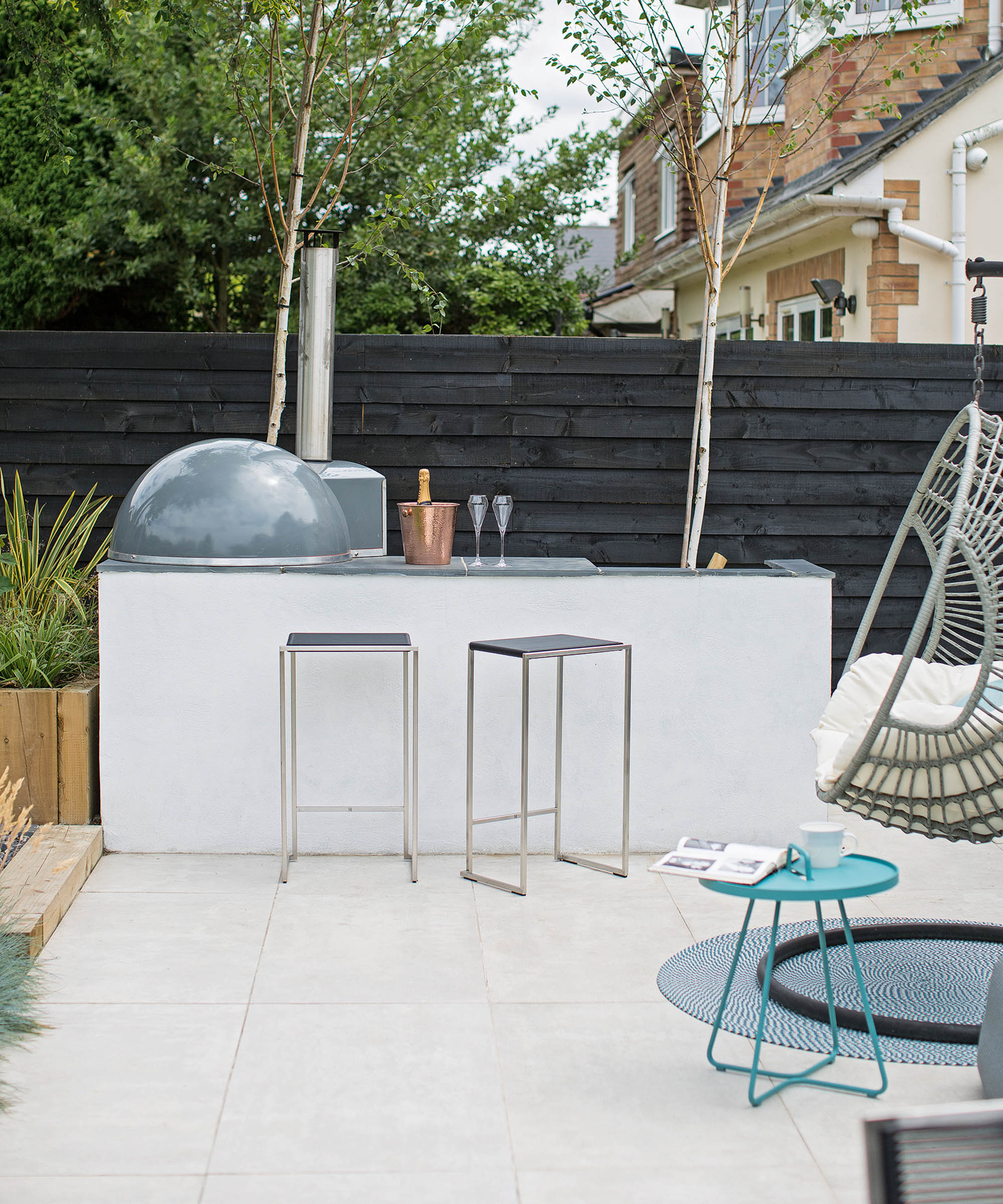
Black painted fences can enhance the feeling of space in a small garden
How do I choose a fence color?
Choosing a new fence color will impact the overall look and style of your garden and home. Here are some tips from garden design expert Samantha Jones at MyJobQuote on what to consider before choosing your fence color.
- The style of your home should have a significant impact on the garden fence color you choose because you want the two to complement each other. Look through gardening magazines to see what types of houses suit different fence colors, then match these to your own home to get a better idea of what will suit your style.
- Natural wooden fences look great in gardens with a lot of greenery and foliage, whereas brighter colors can complement colorful features or any flowering plants in the garden.
- It is a good idea to check that your neighbourhood does not have any fencing color restrictions – some may have these policies in place to prevent items from looking out of place with the surrounding area.
- Finally, if the fence is shared between you and a neighbor, it's a good idea to check they are happy with your chosen color before painting it. After all, they stare at the fence just as much as you do!
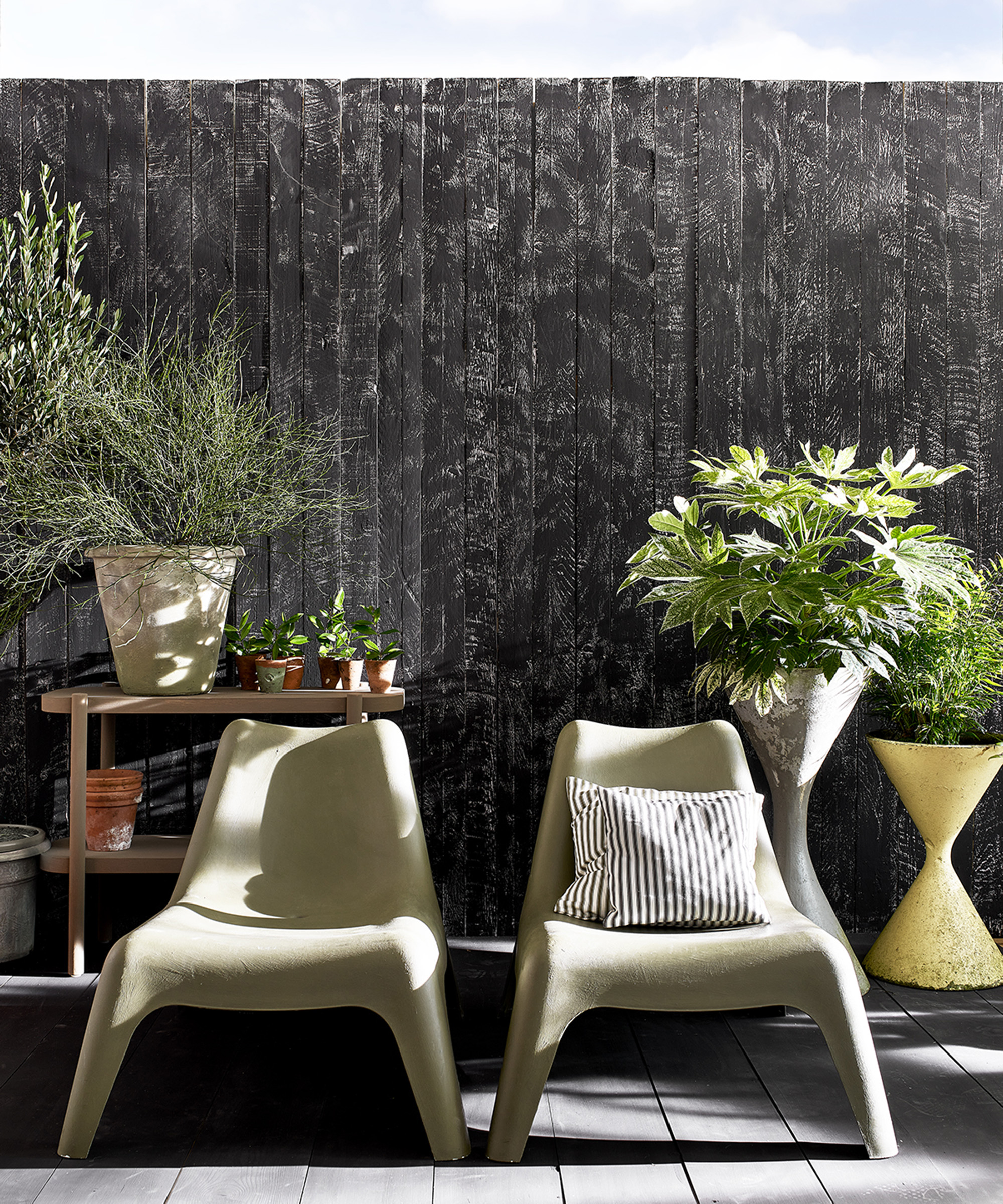
Chalk paint from Annie Sloane will work as a garden fence paint

Teresa has worked as an Editor on a number of gardening magazines for three years now. So she is lucky enough to see and write about gardening across all sizes, budgets and abilities. She recently moved into her first home and the garden is a real project! Currently she is relishing planning her own design and planting schemes. What she is most passionate about when it comes to gardening are the positive effects it has on our mental health to grow and care for plants, as well as being great for the environment too and help provide food and shelter for wildlife.
